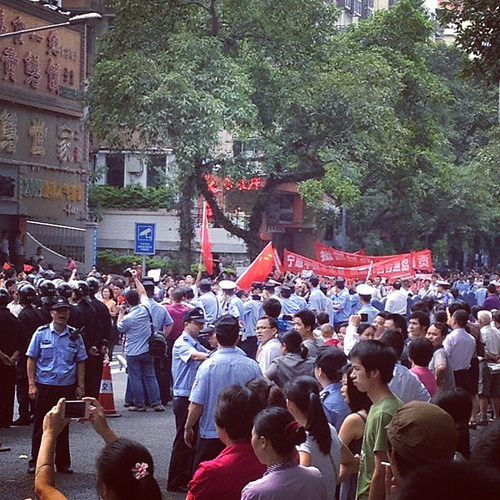Beijing Tries To Dampen Anti-Japan Protests On 9/18 Anniversary

Fearing that protests were developing into turmoil, the Ministry of Foreign Affairs posted a statement, urging citizens to take appropriate ways in expressing their anger toward Japan, but the Beijing administration still took a hard stance on the disputed islands.
Even China’s largest search engine, BAIDU, engaged in the nationwide protest, changing its homepage background to an image of the small islands with the Chinese flag on it.
“Diaoyu Island belongs to China”, the most popular slogan among protesters also appeared on BAIDU’s page. On Tuesday, many citizens seemed be to more cautious in comparison to last week’s protest, during which mobs smashed Japanese cars, looted Japanese shops and threw eggs at the Japanese Embassy in Beijing and Shanghai.
Police in Shandong, a province in North China stepped up security and promised to investigate damages made to cars during protests. Bu Yuying, a chemical factory owner said he did not count on the police to locate the culprits. He paid around $400 for replacing the windshield of his Toyota Crown.
“I just park my car outside my office. In the afternoon, the window was shattered,” he said.
Bu is not just frustrated over the broken windshield.
"I get the feeling that people not only want our island back, they want more," he said. "I have to say that the mobs vent their anger on my car not only because it’s a Japanese car but also because it’s an expensive car. They are jealous of me.”
Bu had a reason to worry about anti-rich sentiment. A large portrait of Chairman Mao showed up in protests, a symbol of an ultimate communism society where everyone is equal. With the income gap between rich and poor increasing and the GDP falling under 8 points, people were giving the protests new meanings. The disputed islands and social problems accumulated over years all play roles in flaring anger.
Qiao Jing, a researcher from Shanghai University of Finance and Economics, called last week’s protests a “circus." She visited her parents in Xi’an in Northwest China when she saw mobs turn a Nissan upside down. The crowd burst into cheers as the owner, with blood over his face, was lifted out.
“Those people were insane,” she said. “At that moment, I wanted to escape from the crazy place.”
In another city, protesters threatened to cut down 50-year-old cherry blossom trees in Wuhan University.
“Basically, protesters believe everything that is relevant to Japan should be wiped out,” said Zhu Yuanyuan, a senior at Wuhan University. "Even cherry trees of Chinese breed.”
Thousands of protests across China did not bring an end to the dispute. Diaoyu Island, as known in China, has been a key factor in causing tension between China and Japan. Outside countries are not willing to take sides in the escalated dispute, supporting Japan or China.
A video of a Washington correspondent from the Xinhua News Agency bombarding and embarrassing Victoria Nuland, spokeswoman for the U.S. Department of State, with questions about the island went viral and won applause from Chinese netizens.
Read more of Neon Tommy's coverage on the island dispute between Japan and China here.
Reach Staff Reporter Meng Meng here.



